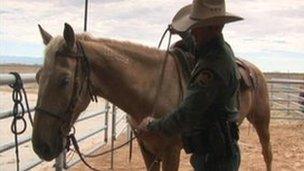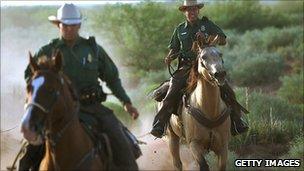Horses play a vital role in American border security
- Published
The United States has invested millions in attempting to secure its border with Mexico. But in an age of advanced surveillance technology, one of the most effective policing methods is as old as the border itself.
When Congress first established the US Border Patrol in 1924, it was strictly an equine affair.
Applicants for early patrol jobs were asked to provide their own horse and tack, but the government would provide horse feed.
The jobs paid comparatively well and, by 1934, the Border Police Chief demanded that aspiring agents fulfil a range of criteria that wouldn't pass muster with today's anti-discrimination policies.
He decreed that agents be "not less than 23 nor more than 30 years of age; not less than 5'8" in height, nor less than 147 pounds, with good visual acuity without glasses and normal visual fields and colour vision".
By 1954, agents were required to have at least 14 natural teeth and replace any missing ones with "suitable prosthetics".
Of course these days such requirements seem archaic. But while the notion of horse patrols might seem similarly antiquated - especially in an era of heat sensors and unmanned aerial vehicles - they are still an invaluable part of the border security effort.
Wild mustangs
In the rocky, desert territory outside El Paso, Texas, sure-footed horses can traverse ground that four-wheel drive or all-terrain vehicles cannot.
Mustangs, the iconic American frontier horse, are often used. Their big hooves and dense bone structure mean they can easily roam rugged ground for nine-hour shifts.

Border police use mustangs - iconic American horses - which are caught in the wild and broken in
Many of the mustangs are caught in the wild - mainly in Rocky Mountain states like Wyoming or Idaho - before being broken in and trained for border work.
Being close to the ground has advantages. On horseback, it is easier for agents to "sign cut" - the process of looking for disturbances in the natural environment that can lead them to drug- or people-smugglers.
Many criminals make serious attempts to cover their tracks. Some have carved wooden "hooves" which they attach to their feet to try to make their tracks look like those of cattle.
In sandy or dry areas, some have used leaf-blowers to erase their footprints. Others strap large foamy sponges to their shoes to disperse prints.
But trained agents say they can spot all these methods.
Night vision
Most patrols set out at dusk and work through the evening, which is when much of the drug- and people-smuggling activity occurs.

Patrolling the massive US border requires a mix of hi-tech and low-tech methods
Horses have an advantage over other means of transport at this time of day. They're quiet, and they act as the eyes, ears and nose of an agent.
Horse Patrol supervisor Bill Schadle, who works the El Paso sector of the border, describes his horses as being like a "thousand pound pair of night vision goggles".
He says that even in pitch-black darkness, he trusts his horses.
"If you're following people, they're going to let you know if they're close," Mr Schadle says.
If smugglers or illegal immigrants have been spotted on treacherous ground by helicopters or cameras, agents will wait on horses for them to approach.
The horse will always know well before its rider that the people are nearby.
"You can start to feel their heart beating in your legs. You'll see the ears go up," he says, and the agent will know the action is about to start.
- Published28 July 2010
- Published29 July 2010
- Published29 July 2010